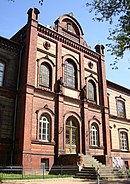Johann Albrecht style
The Johann Albrecht style is a special form of Renaissance architecture named after Duke Johann Albrecht I in Mecklenburg , which was (re) discovered in the course of historicism in the 19th century or further developed as a new tradition and as a regional neo-renaissance building style Flourished.
history

In the course of the reconsideration of "patriotic antiquities" in the first half of the 19th century, Georg Christian Friedrich Lisch described the reign of Johann Albrecht I as the heyday of Mecklenburg history . Johann Albrecht ruled in the Mecklenburg-Güstrow region from 1547 to 1556 and in the Mecklenburg-Schwerin region from 1556 to 1576; In 1549 he pushed through the Reformation for the entire state of Mecklenburg in the state parliament . The prince's court in Wismar , Gadebusch Castle and the Renaissance parts of the Schwerin Castle are prototypes of the architectural style he cultivated . Characteristics of the style, which was based on palazzi in Italy, were arched windows and semicircular gable ends, strong portals and the rich use of terracottas as window frames, friezes and medallions. The terracottas mostly came from the workshop of Statius von Düren .
As was the case with the Renaissance style in the 16th century, the inclusion of the Johann Albrecht style in the 19th century initially represented a princely architectural style . After the reconstruction and construction of the Schwerin Palace, where the terracottas were restored and supplemented and the Obotrite staircase was rebuilt in this neo-renaissance style, a number of state and private buildings in the Johann Albrecht style with elaborate terracotta cladding were built in Mecklenburg in the second half of the 19th century. The so-called citizens' buildings were mainly built in the Hanseatic cities, some of which are still preserved today; their accumulation in Schwerin is probably attributable to the Grand Ducal Art brickyard that in 1845 under the direction of Georg Adolph Demmler before Wismartor the Kläterberg on the south western shore of Schwerin brick interior lake was established to produce new terracotta at Schwerin Castle.
It has now been proven that the terracottas of the 16th century were originally colored, which was not known in the 19th century. The terracottas on buildings from the 19th century were and are consistently natural colors and remained a defining stylistic feature of the Johann Albrecht style, although the contrast between red terracottas and light plaster or yellow brick is unhistorical.
buildings
literature
- Friedrich Sarre : The Fürstenhof zu Wismar and the North German terracotta architecture in the Renaissance era. Berlin 1890.
- Matthias Schubert: Duke Johann Albrecht I and his royal court of Wismar. In: Wismarer Contributions Heft 5, 1988 pp. 37–45.
- Maren Ulbrich: The Wiligrad Castle and Mecklenburg terracotta architecture of the 19th century. Dipl. Thesis Greifswald 1992.
- The Johann Albrecht style: terracotta architecture of the Renaissance and Historicism; Publication for the exhibition in the Hofdornitz in the castle of Schwerin, June 7th to September 24th 1995. Schwerin 1995.
- Gerhard Steiniger: Carl Albrecht Haupt - A Lower Saxony and the Johann Albrecht style. In: Builders in Mecklenburg from eight centuries. Schwerin 1998 ISBN 3-928820-88-5 pp. 189-193.
- Mecklenburg Yearbooks MJB (1840) Volume 5.
- Matthias Zahn: Building history studies at the Fürstenhof in Wismar. In: Wismarer Contributions Issue 15, 2003 pp. 77–85.
- Ralf Weingart: The reconstruction of Schwerin Castle and the 'invention' of the Johann Albrecht style . In: First Schwerin World Heritage Conference, 22. – 23. October 2015, proceedings . Schwerin 2016, pp. 67-100.
Web links
- Literature on Johann Albrecht style in the state bibliography MV
- Johann Albrecht and his style - 19th century terracotta architecture in Schwerin
Individual evidence
- ^ Johann Albrecht and his style - 19th century terracotta architecture in Schwerin
- ^ Horst Ende : Fürstenhof Wismar. In: The Johann Albrecht Style. 1995 pp. 39-47.
- ^ Friedrich Lisch: History of the princely residence castles at Wismar, Pig and Gadebusch. MJB Vol. 5 (1840) pp. 31-36.
- ^ Thomas Brockow: Reception of terracotta architecture in the 19th century. In: The Johann Albrecht Style. 1995 p. 154.
- ↑ Elke Onnen: The Johann Albrecht style in the country palaces and town houses of the 16th century. In: The Johann Albrecht Style. 1995 p. 85.
- ↑ Thomas Brockow: The research project "Preservation of historical terracottas". In: Johann Albrecht Style. 1995 pp. 159-165.











